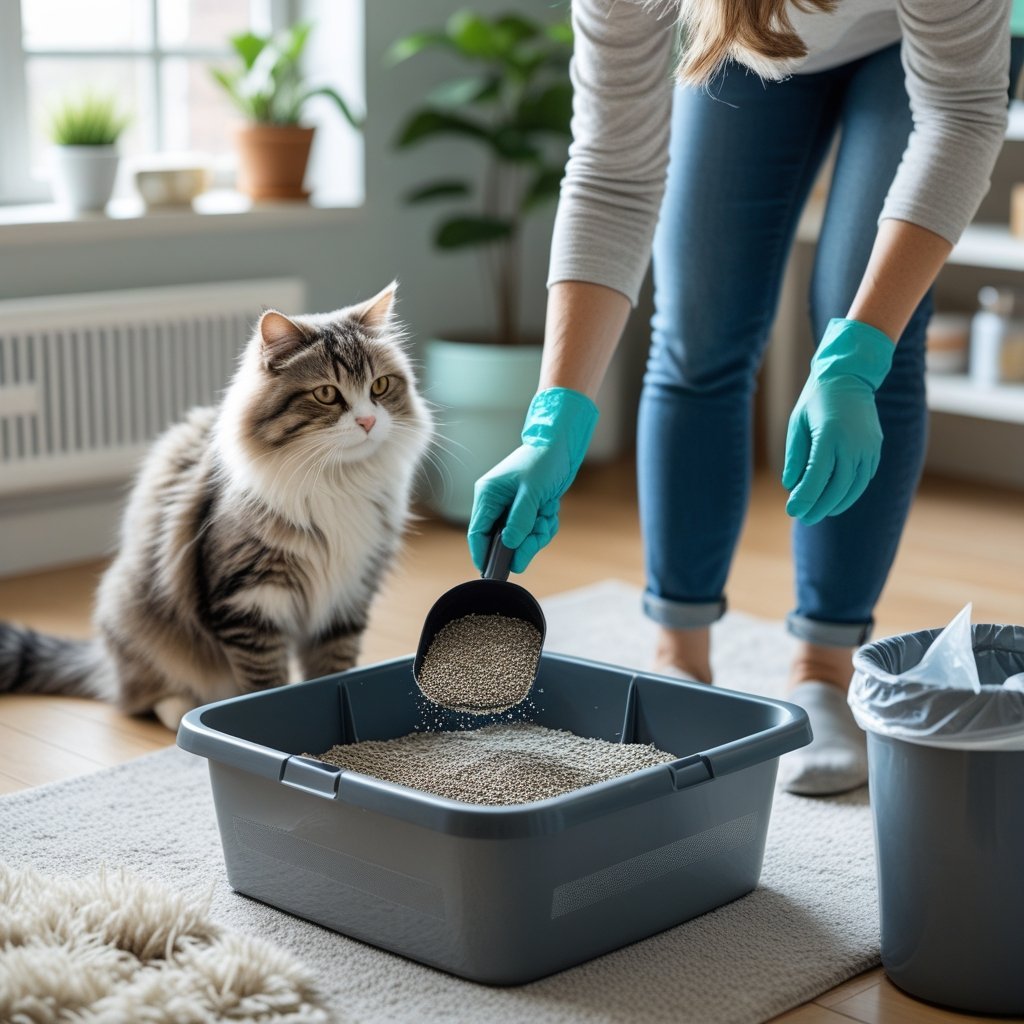Meta Description: Learn how to litter train cats of any age with expert tips and proven techniques. From kittens to senior cats, discover successful litter box training strategies that work.
Litter box training is one of the most essential skills your cat will need to master, yet many cat owners feel overwhelmed when facing training challenges, especially with older cats who may have developed bad habits or never received proper training. The good news is that cats have a natural instinct to bury their waste, making them generally easier to house-train than many other pets. However, successful litter training requires understanding feline psychology, providing appropriate equipment, and addressing any obstacles that might prevent your cat from using their litter box consistently.
Whether you’re bringing home a young kitten, adopting an adult cat from a shelter, or dealing with litter box issues in a previously trained cat, the principles of successful litter training remain remarkably consistent. Cats are naturally clean animals who prefer to eliminate in areas that feel safe, private, and comfortable. When these conditions aren’t met, even well-trained cats may refuse to use their litter boxes, leading to frustrating accidents and damaged household items.
From selecting the perfect litter box and choosing the right litter type to understanding placement strategies and troubleshooting common problems, successful litter training involves multiple factors working together. This comprehensive guide will walk you through every aspect of litter training cats of all ages, providing proven strategies, expert insights, and practical solutions that transform even the most challenging litter box situations into success stories.
Understanding Feline Elimination Instincts
Before diving into training techniques, it’s crucial to understand the natural behaviors and instincts that influence how cats approach elimination.
Natural Bathroom Behaviors

Burying Instinct: In the wild, cats bury their waste to hide their scent from predators and competitors. This deeply ingrained behavior makes most cats naturally inclined to use loose, diggable substrates like litter.
Privacy Preference: Cats prefer to eliminate in areas where they feel safe and won’t be disturbed during this vulnerable activity. This explains why many cats refuse to use boxes in high-traffic areas or near loud appliances.
Territorial Marking vs. Elimination: Understanding the difference between normal elimination and territorial marking (spraying or inappropriate elimination) is crucial for addressing litter box problems effectively.
Substrate Preferences: Cats develop preferences for certain textures, smells, and depths of litter material, often based on early experiences. These preferences can be quite strong and influence litter box success.
Age-Related Considerations
Kittens (0-4 months): Young kittens learn elimination behaviors from their mothers and typically begin using litter boxes around 3-4 weeks of age with minimal training required.
Adult Cats (1-7 years): Adult cats may come with established habits, both good and bad. They’re capable of learning new behaviors but may require patience during transition periods.
Senior Cats (7+ years): Older cats may have mobility issues, cognitive changes, or health problems that affect litter box use and require modified approaches and accommodations.
Essential Litter Box Equipment and Setup
Choosing appropriate litter box equipment is fundamental to training success, as the wrong setup can discourage even naturally inclined cats from using their boxes.
Litter Box Selection
Size Matters: Boxes should be at least 1.5 times the length of your cat from nose to base of tail. Larger cats like Maine Coons need extra-large boxes, while kittens start with smaller boxes and graduate to adult sizes.
Covered vs. Uncovered: While covered boxes contain odors and litter scatter, many cats prefer open boxes that don’t trap smells or limit their view of surroundings. Start with uncovered boxes unless you know your cat’s preferences.
Entry Height: Standard boxes work for most cats, but senior cats, kittens, or cats with mobility issues benefit from boxes with lower entry sides or cut-down entrances.
Material Quality: Choose boxes made from durable, non-porous materials that won’t absorb odors or stain over time. Avoid boxes with rough seams or edges that might be uncomfortable.

Litter Type Selection
Clay Litter: Traditional clay litter is economical and familiar to most cats. Clumping varieties simplify cleaning but may not be ideal for very young kittens who might ingest it.
Natural Alternatives: Corn, wheat, pine, and paper-based litters offer eco-friendly options. Some cats prefer these textures, while others may refuse them initially.
Crystal/Silica Litter: These litters absorb moisture and control odors well but may feel uncomfortable to some cats due to their harder texture.
Unscented vs. Scented: Most experts recommend unscented litter, as cats have sensitive noses and may avoid boxes with strong artificial fragrances.
Depth Guidelines: Most cats prefer 2-3 inches of litter depth. Too shallow doesn’t allow proper burying, while too deep may feel unstable.
Optimal Box Placement
Privacy Without Isolation: Place boxes in quiet, low-traffic areas that are easily accessible but provide privacy during use. Avoid placing boxes in completely isolated areas like dark basements.
Multiple Floor Coverage: In multi-level homes, provide at least one box per floor to ensure access regardless of where your cat is when the urge strikes.
Distance from Resources: Keep litter boxes away from food and water bowls, as cats naturally prefer to eliminate away from eating areas.
Avoiding Problem Areas: Never place boxes near loud appliances, in cramped spaces where cats might feel trapped, or in areas with poor ventilation.
Step-by-Step Litter Training for Kittens
Young kittens are typically the easiest to litter train, as they’re naturally inclined to use appropriate substrates and readily learn from demonstration.
Initial Introduction (3-4 weeks)
First Exposure: Place kittens in the litter box shortly after eating, sleeping, or playing – times when they’re most likely to need elimination.
Gentle Demonstration: Gently take their paw and make scratching motions in the litter to demonstrate the digging action, though most kittens instinctively understand this behavior.
Frequent Reminders: During the first few days, place kittens in the box every 1-2 hours and after meals to establish the routine.
Positive Reinforcement: Praise kittens calmly when they use the box successfully, using gentle verbal encouragement without excessive excitement that might startle them.

Establishing Routine (4-12 weeks)
Consistent Schedule: Maintain regular feeding times, which lead to more predictable elimination schedules and easier training success.
Multiple Box Access: Provide several boxes throughout the kitten’s accessible space to ensure one is always nearby during this critical learning period.
Supervision Strategy: Monitor kittens during free time and gently redirect them to the litter box if you notice pre-elimination behaviors like sniffing, circling, or squatting.
Accident Management: Clean accidents thoroughly with enzymatic cleaners to eliminate odor traces that might encourage repeat incidents in inappropriate locations.
Training Adult and Senior Cats
Older cats can absolutely learn to use litter boxes, though the approach may require more patience and understanding of their individual histories and preferences.
Assessing Previous Experience
Shelter or Rescue Cats: Many adult cats from shelters are already litter trained but may need time to adjust to new box types, litter brands, or household layouts.
Previously Outdoor Cats: Cats transitioning from outdoor to indoor living may prefer outdoor-like substrates initially, such as soil or sand, before gradually transitioning to commercial litter.
Cats with Bad Habits: Cats with established inappropriate elimination patterns need behavior modification approaches that address underlying causes while retraining proper box use.
Modified Training Approach
Gradual Introduction: Allow adult cats to explore the box at their own pace without forcing interaction, which can create negative associations.
Preference Testing: Offer multiple box types, litter varieties, and locations initially to identify preferences, then standardize once successful patterns emerge.
Extended Timeline: Adult cats may need several weeks to establish consistent litter box habits, especially if overcoming previous negative experiences or preferences.
Medical Rule-Out: Always consult a veterinarian to rule out medical issues like urinary tract infections, kidney disease, or arthritis that might affect litter box use in adult cats.
Special Considerations for Senior Cats
Accessibility Modifications: Provide boxes with very low entries or ramp access for cats with arthritis or mobility limitations.
Cognitive Support: Senior cats with cognitive decline benefit from more boxes placed in obvious locations with clear paths and minimal obstacles.
Medical Monitoring: Age-related health issues commonly affect elimination, making veterinary consultation crucial for senior cats with litter box problems.
Comfort Accommodations: Softer litters, larger boxes, and boxes placed near favorite resting spots help senior cats maintain good litter box habits.
The “Magic Number” Rule: Multiple Boxes
One of the most important principles in successful litter training and maintenance is providing adequate numbers of litter boxes throughout your home.
The N+1 Formula
Basic Rule: Provide one litter box per cat, plus one extra box. For example, a one-cat household needs two boxes, while three cats require four boxes.
Reasoning Behind Extra Boxes: This ensures that if one box is soiled or occupied, cats always have clean alternatives available, preventing accidents from desperation.
Territory Management: Multiple boxes reduce territorial conflicts in multi-cat households where dominant cats might block access to single boxes.
Strategic Box Distribution
Separate Locations: Distribute boxes throughout the home rather than clustering them all in one area, which cats may perceive as a single large bathroom.
High-Use Areas: Place boxes near areas where cats spend significant time to ensure convenient access when needs arise.
Problem-Solving Placement: If accidents occur in specific locations, temporarily placing a box in that spot can redirect behavior while identifying underlying causes.

Troubleshooting Common Litter Box Problems
Even with proper setup and training, litter box issues can develop. Understanding and addressing these problems quickly prevents bad habits from becoming entrenched.
Box Avoidance Issues
Cleanliness Problems: Cats may refuse dirty boxes. Scoop daily, completely change litter weekly, and deep clean boxes monthly with mild soap and water.
Wrong Litter Type: If your cat suddenly stops using their box after a litter change, return to the previous type or gradually transition over 7-10 days by mixing old and new litters.
Box Size or Style: Cats may outgrow boxes or develop preferences for different styles. Try offering alternative box types while maintaining familiar options.
Location Issues: Changes in household layout, new furniture placement, or increased traffic near boxes may make cats uncomfortable using previous locations.
Medical vs. Behavioral Issues
Health Red Flags: Straining, crying during elimination, blood in urine or stool, or sudden changes in bathroom habits warrant immediate veterinary evaluation.
Stress-Related Problems: Major household changes, new pets, construction, or schedule disruptions can trigger stress-related elimination issues requiring behavioral intervention.
Age-Related Changes: Senior cats may develop arthritis, cognitive decline, or other conditions affecting box use. Medical management and environmental modifications both help.
Marking vs. Elimination
Spray Marking: Vertical spraying on walls or furniture differs from squatting elimination and typically indicates territorial stress requiring different interventions.
Horizontal Marking: Some cats mark horizontally on soft surfaces like beds or clothing, usually indicating stress or anxiety rather than litter box training issues.
Solutions for Marking: Address underlying stress causes, consider pheromone products, increase environmental enrichment, and consult veterinarians about potential medical causes.
Transitioning Outdoor Cats to Indoor Litter Use
Cats accustomed to outdoor elimination can successfully transition to litter boxes with patience and appropriate techniques.
Initial Setup for Outdoor Cats
Outdoor Substrate Simulation: Start with soil, sand, or pine litter that mimics outdoor textures, then gradually mix in commercial litter over several weeks.
Gradual Confinement: Begin by keeping outdoor cats indoors during times when they typically eliminate, gradually extending indoor time as litter box use becomes consistent.
Multiple Transition Boxes: Provide several boxes with various substrates initially to accommodate preferences while establishing indoor bathroom habits.
Progressive Training Steps
Week 1-2: Use outdoor substrates in boxes, immediately showing cats the boxes and placing them inside after bringing them indoors from outside bathroom trips.
Week 3-4: Begin mixing 25% commercial litter with outdoor substrates, maintaining this ratio while monitoring acceptance and consistent use.
Week 5-6: Increase commercial litter to 50%, then 75%, closely monitoring for any rejection or accidents indicating the transition is too rapid.
Week 7+: Complete transition to commercial litter once the cat demonstrates consistent, comfortable use at the 75% mixture stage.

Maintaining Long-Term Success
Once litter training is established, ongoing maintenance and attention ensure continued success throughout your cat’s life.
Cleaning and Maintenance Schedule
Daily Tasks: Scoop all boxes at least once daily, preferably twice, to maintain cleanliness standards that cats expect and deserve.
Weekly Tasks: Completely dump and replace litter, wipe down box interiors, and check for any cracks, stains, or odor absorption indicating replacement needs.
Monthly Tasks: Deep clean boxes with mild soap and water, replace old boxes showing wear, and reassess box placement for any household changes.
Monitoring and Adjustment
Behavioral Observation: Stay alert to changes in litter box use patterns, frequency, or appearance of waste that might indicate health problems requiring veterinary attention.
Life Stage Adaptation: Adjust box numbers, types, and placements as cats age, household compositions change, or mobility limitations develop.
Environmental Changes: When making household changes, consider impacts on litter box accessibility and comfort, proactively addressing potential issues.
Frequently Asked Questions About Litter Training
Q: At what age should I start litter training a kitten?
A: Most kittens naturally begin using litter boxes around 3-4 weeks of age. Mother cats often teach this behavior, but human guidance during this period reinforces proper habits.
Q: Can I train an older outdoor cat to use a litter box?
A: Yes, outdoor cats of any age can learn indoor litter box use with patience, appropriate substrate transitions, and gradual training approaches tailored to their established habits.
Q: How long does litter training typically take?
A: Kittens often learn within days, while adult cats may need 2-4 weeks depending on their history. Outdoor cats transitioning to indoor use may require 6-8 weeks of gradual substrate changes.
Q: What should I do if my trained cat suddenly stops using the litter box?
A: First, consult your veterinarian to rule out medical issues. If health is confirmed, evaluate box cleanliness, litter type, location, and household stress factors that might trigger behavioral changes.
Q: Is it ever too late to litter train a cat?
A: No, cats of any age can learn litter box use. However, older cats may require more patience, accommodation for physical limitations, and veterinary consultation to address potential health issues.
Conclusion: Patience and Understanding Lead to Success
Litter training cats of any age is absolutely achievable with proper understanding, appropriate equipment, and patient, consistent approaches tailored to individual needs. While kittens naturally take to litter boxes with minimal intervention, adult and senior cats can successfully learn or relearn proper bathroom habits when given the right support and environment.
The keys to successful litter training lie in understanding feline psychology, providing optimal equipment and placement, maintaining impeccable cleanliness standards, and addressing problems promptly with appropriate solutions. Whether you’re training a tiny kitten, helping a shelter cat adjust to a new home, transitioning an outdoor cat to indoor living, or troubleshooting issues with a previously trained cat, the principles remain consistent: patience, cleanliness, accessibility, and respect for natural feline preferences.
Remember that litter box problems often indicate underlying medical issues, stress, or environmental inadequacies rather than willful misbehavior. Approaching challenges with curiosity and compassion rather than frustration leads to faster solutions and stronger bonds with your feline companion.
By implementing the strategies outlined in this guide and remaining attentive to your cat’s individual needs and preferences, you can establish and maintain excellent litter box habits that last throughout your cat’s lifetime. The investment in proper training and maintenance pays dividends in household cleanliness, reduced stress for both you and your cat, and the satisfaction of meeting your cat’s fundamental needs with understanding and care.
What litter training challenges have you overcome with your cats? Share your success stories and tips in the comments below!
Ready to set up the perfect litter box system? Check out our recommendations for high-quality litter boxes, effective litter types, and cleaning supplies that make maintaining excellent bathroom habits easier for both you and your cat.
Related Articles You Might Enjoy:
- “Common Health Problems in Cats (and Prevention Tips)”
- “Why Does My Cat Knock Things Over?”
- “Best Cat-Friendly Indoor Plants (and Toxic Ones to Avoid)”
- “Top 10 Friendliest Cat Breeds for Families”
Keywords: litter train cat, cat litter box training, train older cat litter box, kitten litter training, cat bathroom training, litter box problems, cat elimination issues, house training cats, litter box setup

